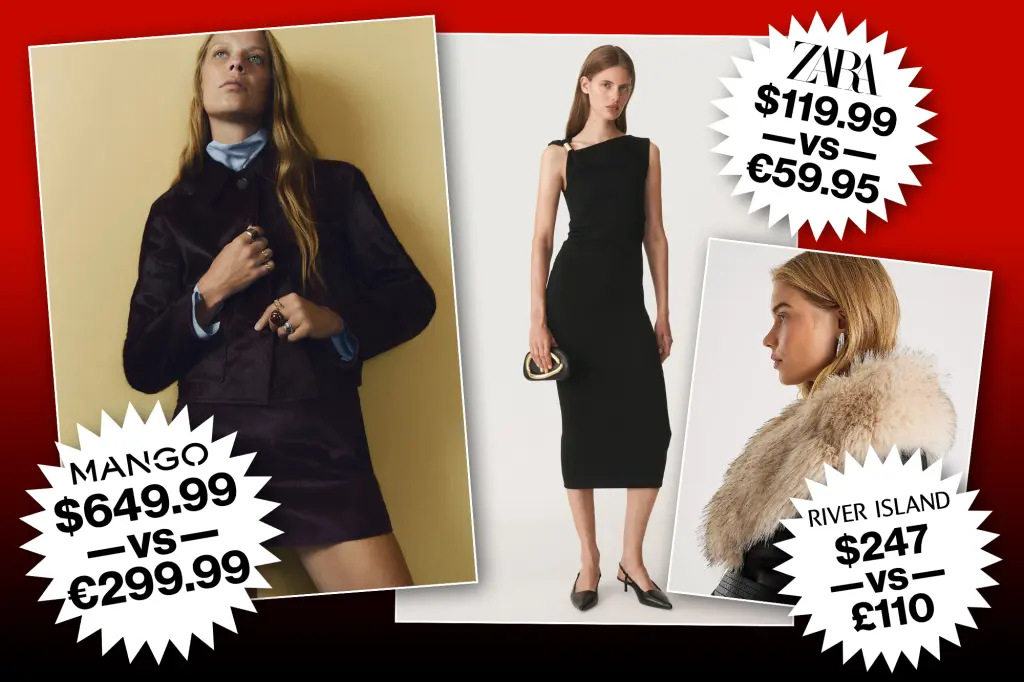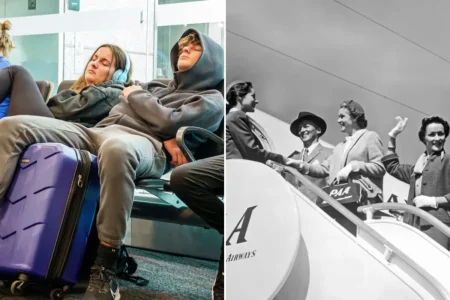Global Fashion’s Price Puzzle: Why Americans Pay More for European Brands
The Growing Price Gap Between Europe and America
The love affair between American shoppers and European fast-fashion giants like Zara, Mango, and River Island has hit a rough patch. While these brands continue to deliver on style, their once-reasonable prices have surged dramatically for U.S. consumers, leaving many fashion enthusiasts questioning the stark price differences between what Europeans and Americans pay for identical items. The pricing discrepancy has grown so noticeable that shoppers are increasingly vocal about their frustration, with some even calculating that international travel might be more economical than paying domestic markups. What’s particularly puzzling is that while tariffs imposed by the Trump administration (10% on UK goods and 15% on EU products) are certainly a factor, they don’t come close to explaining price hikes that sometimes reach nearly 100% more for American shoppers.
Shocking Price Comparisons Reveal the Extent of the Problem
The evidence of these dramatic price differences is both clear and compelling. Take Mango’s distressed cowhide jacket with fur-lined pockets – Spanish shoppers pay €299.99 (about $351), while Americans are charged a staggering $649.99 for the identical item, representing an 85% increase. Even more modest items show similar patterns: a simple ruffled Mango cardigan priced at €29.99 ($35) in Spain jumps to $69.99 in America – a nearly 100% markup. River Island’s trendy faux shearling-lined trench coat costs British shoppers £110 (approximately $147) but commands $247 from American fashion lovers – 68% more. Zara follows the same pattern, with a sleek little black dress with gold detailing selling for €59.99 ($70) in Spain but $119 in the United States. These differences go far beyond what can be explained by shipping costs or standard tariffs, leaving consumers increasingly suspicious and frustrated.
Social Media Amplifies Consumer Awareness and Outrage
As more shoppers become aware of these price disparities, social media has become a platform for their frustration. Influencer Maggie Awbrey expressed her surprise when she discovered a Zara purse she purchased for $75 in the U.S. had a European price tag of €35 (about $40) still attached. Similarly, Zara enthusiast Bryce Gruber documented her shock while shopping in Athens, claiming prices were nearly half what she’d paid at home earlier that year, even after currency conversion. “It is outrageous,” she told her viewers, encouraging them to “Come to Greece and load your baskets.” This growing awareness has sparked a conversation about value, fairness, and whether these European brands are taking advantage of American consumers’ willingness to pay premium prices for European fashion cachet. The transparency enabled by social media and international travel has made these pricing strategies increasingly difficult for brands to maintain without explanation.
Experts Offer Complex Explanations Beyond Simple Greed
While consumer frustration is understandable, retail experts suggest the situation is more nuanced than simple price gouging. Michael Goldman of Caru Containers explained to The Post that “The impact of a tariff can far exceed just the literal cost.” Companies may be inflating prices well beyond actual tariff costs to offset anticipated market share losses and meet investor expectations. There’s also the straightforward explanation of market-based pricing – charging what consumers in different markets are willing to pay rather than basing prices strictly on costs plus reasonable markup. Professor Shelley Kohan of Syracuse University noted that these pricing decisions are backed by extensive analytics, arguing that “Retailers don’t normally price gouge their loyal customer base.” The lack of comment from Zara, Mango, and River Island when contacted about their pricing strategies leaves consumers to speculate about the true reasons behind the dramatic differences.
H&M Bucks the Trend with Near-Uniform Global Pricing
Not all European fashion retailers have embraced differential pricing strategies. Swedish giant H&M stands out as an exception, maintaining remarkably consistent prices between its home country and the United States. While other brands show markups of 60-100%, H&M’s price differences typically stay within 5-7% – sometimes even favoring American consumers. For instance, a pleated skort costs 349 krona ($37) in Sweden compared to $39.99 in the U.S., reflecting just a 5% increase. Even more surprisingly, a fine-knit cashmere sweater priced at 1,399 krona ($149) in Sweden sells for $139 in America, actually representing a 7% discount for U.S. shoppers. H&M’s CEO Daniel Ervér has explained this approach as the result of strategic adaptations, including shifting production away from countries targeted by high tariffs and implementing cost-saving technologies like self-checkout systems and RFID tagging. This demonstrates that maintaining reasonable price parity is possible with the right business strategies, raising further questions about other brands’ pricing decisions.
Creative Consumer Solutions: When Shopping Becomes Tourism
As price differences continue to widen, determined fashion lovers are getting creative with their shopping strategies. Some are turning European vacations into tactical shopping expeditions, bringing empty suitcases to fill with fashion finds at local prices. Brooklyn resident Tiffany Radulescu summed up this approach with her quip: “I’d rather catch a flight than catch a tariff.” The Post’s own Wellness Editor Carly Stern recently put this strategy into practice during a trip to Barcelona, where she purchased a Zara midi dress for $47.10 – a significant savings compared to its $79.90 price tag in New York. “It’s girl math – fly to Europe, buy some clothes. I literally saved $30 – that’s just smart finances,” Stern reasoned, only half-joking. While this approach isn’t practical for most consumers, it highlights the extraordinary lengths some shoppers will go to avoid what they perceive as unfair pricing. As awareness grows about these international price differences, brands may face increasing pressure to justify their pricing strategies or risk alienating their American customer base who increasingly feel they’re paying an unjustified premium for their European fashion fix.















